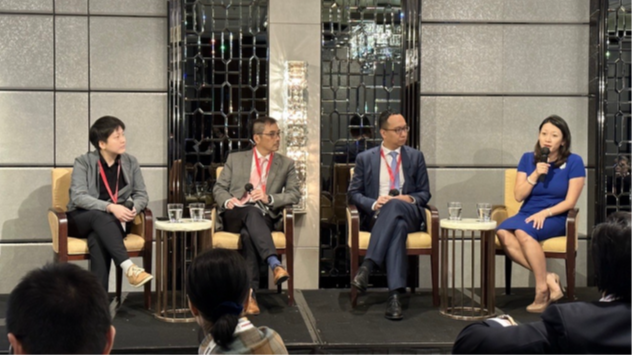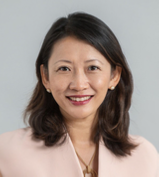March 30, 2023
The Hong Kong family office is repositioning its public assets portfolio of equities, bonds and cash to capture different opportunities in Asia, Europe, and the US.

Nan Fung Trinity has turned more aggressive with its public assets portfolio since late last year, adding positions in Asian equities in order to capture selective opportunities in areas like cyclical and financial stocks
Meanwhile, the family office has moved some stock positions to cash in the developed markets while becoming more active on credit investments with longer duration.

We’re actually very open-minded. So even within the same year as the market conditions may shift, we may have adjustments to our portfolio,” said Helen Zhu, managing director and chief investment officer of Nan Fung Trinity, at AsianInvestor’s Family Office Briefing in Hong Kong on Tuesday.
Since the market has been changing so quickly after the Credit Suisse and Silicon Valley Bank fallouts, Zhu told a panel discussion that it’s important to remain nimble and ready to capture opportunities when the market moves.
Nan Fung Trinity is the family office of Hong Kong business conglomerate Nan Fung Group. A majority of its assets come from the family, while a small portion consists of third-party money from people who are close to the family.
While focusing on compound return rates over the medium to long term, the family office also has the flexibility to capture tactical opportunities.
EQUITY VS CASH
For most of 2022, the family office has been mostly defensive, running on a higher cash balance to avoid major drawdowns in the market as it pursued a global long-only multi-asset strategy on the public side.
In late 2022, during the massive market downturn in Asia’s stock market, led by Hong Kong and Chinese stocks, Nan Fung Trinity saw it as a good opportunity to add Asian exposure.
Meanwhile, at the beginning of the year, as the market was pricing in a likely Goldilocks scenario in the US in which there would be modest economic growth and inflation, the family office took some risk off the developed markets and managed to add some cash positions.
“I wouldn’t say it’s getting much more offensive this year. But it’s shifting our exposures to where we think the better risk-reward may lie,” Zhu said.
In Asia, as some cyclical stocks are coming off previously high demand and peak profitability to settle into a much lower part of the cycle, Zhu said the family office has become a bit more offensive in areas like memory chips, which are experiencing historic trough valuations.
“In some of those areas, we actually think that the recovery may not come as quickly as some people think, but it’s probably a good enough time to position and wait for medium- to longer-term rebound,” Zhu said.
STAYING NIMBLE
On the bond front, Nan Fung Trinity is starting to consider accumulating some positions again, following a lot of stress in the market.
“Clearly, we’re probably not going to go position with the Credit Suisse type of very, very high-risk stuff because we are looking for compounding growth and capital preservation as well,” she stressed.
But as the market edges closer to the top of the rate hike cycle in developed markets, Zhu believed the family office can start to extend the tenor of its credit portfolio at some point this year, as well as to try to position for a potential eventual decline in interest rates.
However, Zhu stressed that it is important to stay flexible with the daily market changes, following the Credit Suisse crisis and the SVB fallout in the past few weeks.
“I think we really have to think about the different market conditions of the Fed pivot. In the case of very robust growth and fading inflation, it is a very positive signal to buy a lot of big tech and so on. But a Fed pivot forced by a global liquidity crisis is not one [where] you want to be buying high beta assets,” she said.
“So, we have to be still quite nimble, although we do want to maintain our medium- to longer-term investment objectives, to really just look at where we think the upside is at least twice the downside,” she added.
In terms of its overall allocation within Asia, Zhu said this year the family office would be more focused on selective pockets in parts of Hong Kong, Taiwan, and Korea markets, which could have a potential downside of 20% but could also go up 40-50%, for example.
Within Asia, the family office would remain selective in terms of sectors, specific names, and geographies.
For example, Nan Fung Trinity won’t be looking at commodities-driven stocks, even though these producers are making historically high profits, as the risk-reward ratio is not favourable, Zhu said.
A DIFFERENT OUTLOOK
Outside of Asia, with the US and Europe nearing the peak of the rate cycle, Zhu said they would allocate more to credit this year compared to before, since this is where the risk-free rates are trending.
“I think in terms of the credit spread, it’s still relatively tight in some places, but much more attractive over the last few weeks. Those are the tactical opportunities that we would look to capture over the coming month,” she said.
Japan and China meanwhile are still at the lower end of the rate cycle, and therefore still have upside when it comes to financial stocks, for instance.
“So, whether it’s a sector allocation or country allocation or specific types of cyclicals, we have specific considerations for each of them, within credit and equities as well,” she said.
¬ Haymarket Media Limited. All rights reserved.